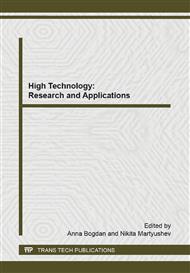[1]
A.M. Lider, M. Krening, V.V. Larionov, G.V. Garanin, Hydrogen migration in metals under the combined action of acoustic and ionizing radiation, Technical Physics. 56 (2011) 1630 - 1634.
DOI: 10.1134/s1063784211110168
Google Scholar
[2]
N.V. Martyushev, Alignment of the microstructure of castings from the heterophase lead bronzes, Advanced Materials Research. 880 (2014) 163 - 167.
DOI: 10.4028/www.scientific.net/amr.880.163
Google Scholar
[3]
N.V. Martyushev, Y.N. Petrenko, Effects of crystallization conditions on lead tin bronze properties, Advanced Materials Research. 880 (2014) 174 - 178.
DOI: 10.4028/www.scientific.net/amr.880.174
Google Scholar
[4]
I.G. Vidayev, N.V. Martyushev, A.S. Ivashutenko, A.M. Bogdan, The resource efficiency assessment technique for the foundry production, Advanced Materials Research. 880 (2014) 141 - 145.
DOI: 10.4028/www.scientific.net/amr.880.141
Google Scholar
[4]
N.V. Martyushev, I.V. Semenkov, The possibility of casting surface alloying by nanopowders, Advanced Materials Research. 880 (2014) 272 - 275.
DOI: 10.4028/www.scientific.net/amr.880.272
Google Scholar
[5]
V.M. Pogrebenkov, K.S. Kostikov, Study of phase formation processes in a three-component system of diopside, porcelain, alumina, in Proceedings of the Russian-German Forum on Nanotechnology, Tomsk Polytechnical University, Tomsk, 2013, pp.201-205.
DOI: 10.4028/www.scientific.net/amr.872.201
Google Scholar
[6]
T.V. Nekrasova, A.G. Melnikov, N.V. Martyushev, Creation of ceramic nanocomposite material on the basis of ZrO2-Y2O3-Al2O3 with improved operational properties of the working surface, Applied Mechanics and Materials. 379 (2013) 77 - 81.
DOI: 10.4028/www.scientific.net/amm.379.77
Google Scholar
[7]
I.B. Ardashkin, Scientific problem in modern cognition process, in Proceedings of the 9th International Scientific and Practical Conference of Students, Post-graduates and Young Scientists - Modern Techniques and Technologies, MTT' 2003, Tomsk Polytechnical University, Tomsk, 2003, pp.260-262.
DOI: 10.1109/spcmtt.2003.1438221
Google Scholar
[8]
D.A. Chinakhov, A.V. Vorobyov, A.A. Tomchik, Simulation of active shielding gas impact on heat distribution in the weld zone, Materials Science Forum. 762 (2013) 717-721.
DOI: 10.4028/www.scientific.net/msf.762.717
Google Scholar
[9]
D.A. Chinakhov, E.P. Agrenich, Computer simulation of thermo-mechanical processes at fusion welding of alloyed steels, Materials Science Forum. 575-578 (2008) 833-836.
DOI: 10.4028/www.scientific.net/msf.575-578.833
Google Scholar
[10]
S. Yu. Tarasov, A.V. Kolubaev, Generation of shear bands in subsurface layers of metals in sliding, Physics of the Solid State. 50 (2008) 844 - 847.
DOI: 10.1134/s1063783408050077
Google Scholar


